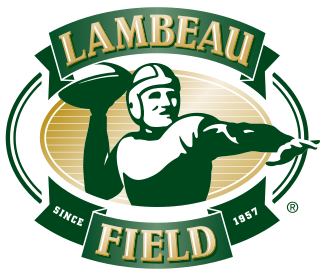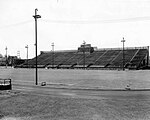
The Green Bay Packers are a professional American football team based in Green Bay, Wisconsin. The Packers compete in the National Football League (NFL) as a member club of the National Football Conference (NFC) North division. It is the third-oldest franchise in the NFL, dating back to 1919, and is the only non-profit, community-owned major league professional sports team based in the United States. Home games have been played at Lambeau Field since 1957. They have the most wins of any NFL franchise.

Earl Louis "Curly" Lambeau was an American professional football player and coach in the National Football League (NFL). Lambeau, along with his friend and fellow Green Bay, Wisconsin, native George Whitney Calhoun, founded the Green Bay Packers in 1919. He served as team captain in the team's first year before becoming player-coach in 1920. As a player, Lambeau lined up as a halfback, which in the early years of the NFL was the premier position. He was the team's primary runner and passer, accounting for 35 touchdowns in 77 games. He won his only NFL championship as a player in 1929.

Lambeau Field is an American football outdoor multi-purpose stadium in Green Bay, Wisconsin. The home field of the Green Bay Packers of the National Football League (NFL), it opened 67 years ago in 1957 as City Stadium, replacing the original City Stadium at Green Bay East High School as the Packers' home field. Informally known as New City Stadium for its first eight seasons, it was renamed in August 1965 in memory of Packers founder, player, and long-time head coach, Earl “Curly” Lambeau, who had died two months earlier.

City Stadium is an American football stadium in Green Bay, Wisconsin, on the north side of the Green Bay East High School property. It was the home of the Green Bay Packers of the NFL from 1925 through 1956. Renovated and downsized, City Stadium remains the home to the adjacent Green Bay East High School athletic teams. Prior to 1925, the Packers played home games at nearby Hagemeister Park and Bellevue Park.

The Lambeau Leap is a touchdown celebration in American football in which a player leaps into the bleachers behind the end zone after scoring. The celebration was popularized after Green Bay Packers player LeRoy Butler jumped into the Lambeau Field bleachers after scoring a touchdown from a fumble recovery against the Los Angeles Raiders on December 26, 1993. The celebration has remained popular ever since, even as the National Football League tightened rules on touchdown celebrations in the early 2000s. Some safety concerns have been noted by players and staff, including inappropriate touching by fans and the possibility of an injury to the player leaping into the bleachers. Although uncommon, the celebration has been attempted by multiple players from opposing teams at Lambeau Field. The Lambeau Leap is an important component of the history and traditions of the Packers.

Mark Hodge Murphy is an American football executive and former player who is the president and chief executive officer (CEO) for the Green Bay Packers of the National Football League (NFL). Murphy, a safety, went undrafted in the 1977 NFL draft after playing college football at Colgate University. He was signed by the Washington Redskins, where he played for eight seasons from 1977 to 1984. With the Redskins, Murphy won Super Bowl XVII, played in another Super Bowl and led the NFL in interceptions in 1983, the year he was named to his only Pro Bowl and received his only First Team All-Pro honor. During his last few years in the NFL he received a Master of Business Administration from American University and then, after his career ended in 1984, a Juris Doctor degree from Georgetown University in 1988. After his playing career, he worked for the NFL Players Association (NFLPA) and then as a trial lawyer for the United States Department of Justice. In 1992, he was hired as the athletic director of his alma mater Colgate University. In 2003, he moved to Northwestern University to serve as their athletic director, a position he held until 2007.
Robert Ernest Harlan is an American former football executive who served as the president of the Green Bay Packers for 19 years. Harlan also held the titles of chairman of the board and chief executive officer for the Packers. He was a graduate of Marquette University, where he later served as the Sports Information Director for six years. After his tenure at Marquette, Harlan worked for the St. Louis Cardinals baseball team for five years in community and public relations. In 1971, he was hired by the Packers as assistant general manager. For the next 18 years, Harlan worked in different positions in the front office for the Packers before being promoted to executive vice president in 1988. In 1989, after the retirement of Robert J. Parins, Harlan was elected as the Packers' ninth president, a position he held until 2008. Harlan became the first team president whose background was primarily in football; all previous presidents of the Packers were local civic leaders or businessmen in the Green Bay, Wisconsin-area.
The 1995 season was the Green Bay Packers' 75th season in the National Football League (NFL), their 77th overall. The Packers finished with an 11–5 record in the regular season and won the NFC Central, their first division title since 1982. In the playoffs, the Packers defeated the Atlanta Falcons 37–20 at home and the defending champion San Francisco 49ers 27–17, on the road before losing to the Dallas Cowboys 38–27, in the NFC Championship Game. Packers' quarterback Brett Favre was named the NFL's Most Valuable Player, the first of three such awards he would win. This was the first season that the Packers played home games exclusively at Lambeau Field, after playing part of their home slate at Milwaukee County Stadium since 1953. After losing their home opener to St. Louis, the Packers would win an NFL-record 25 consecutive home games between the rest of 1995 and early in 1998.
Rockwood Lodge was the training facility of the Green Bay Packers from 1946 to 1950. Originally built in 1937 as a retreat for a local Norbertine Order, the Lodge was purchased by Packers coach and general manager Curly Lambeau in 1946 and then heavily renovated, making it the first self-contained training facility in professional football history. Although the facility was state-of-the-art at the time, many members of the Packers franchise and local fans complained of its high cost, distance from Green Bay, Wisconsin, and its poor practice field. The Lodge burned down in 1950, with the likely cause being faulty electrical wiring or lightning. The Packers received $75,000 in insurance from the fire, which would be used to help reestablish the Packers' long-term financial security. Lambeau resigned from the Packers just a week after the fire, citing a lack of unity in the team's direction between him and the Packers' board of directors. The Rockwood Lodge site would lay vacant for a number of years before being purchased by Brown County, Wisconsin, and developed into a public park.

John Jones is an American former football executive who briefly served as president of the Green Bay Packers. Jones, who was born and raised in New Orleans, Louisiana, attended Loyola University of the South for his undergraduate studies and the University of Wisconsin–Madison for his post-graduate studies, both in the field of journalism. For 11 years, he served as a teacher of journalism at Loyola and as a journalist for New Orleans Times-Picayune. During his career as a journalist, Jones covered the National Football League and the New Orleans Saints. He transitioned from his journalism career to an executive of American football, first with the NFL Management Council and then with two NFL teams: the Jacksonville Jaguars and then the Packers.
The 1919 Green Bay Packers season was their first season of competitive football. The team was formed by Curly Lambeau and George Whitney Calhoun with help from the Indian Packing Company. Lambeau served as team captain, the position closest related to the modern position of head coach, while Willard Ryan served as the official head coach. The club posted a 10–1 record against other teams in Wisconsin and Michigan.
The 1933 Green Bay Packers season was their 15th season overall and their 13th season in the National Football League (NFL). This was the first year of divisional play and Green Bay competed in the Western Division. The team finished with a 5–7–1 record under coach Curly Lambeau, the first losing season in team history. Beginning this season, the Packers began playing some home game in Milwaukee, Wisconsin, at Borchert Field to draw additional revenue, starting October 1, 1933, against the New York Giants.

Dominic John Olejniczak was an American real estate broker, politician, and football executive. Olejniczak served as an alderman of Green Bay, Wisconsin, from 1936 to 1944. He was then elected mayor, serving for 10 years from 1945 to 1955. During his tenure as mayor, a number of large infrastructure projects were completed and city administration was streamlined. Olejniczak was also known for his work with the Green Bay Packers. Over a period of almost 40 years, Olejniczak served as a member of the board of directors, a vice president, president, and chairman of the board. His 24 years as president is the longest tenure of any Packers president. During his presidency, he hired Vince Lombardi in 1959, the Packers won five championships, and the team saw its net worth grow over 5,000%. In recognition of his contributions, Olejniczak was inducted into the Green Bay Packers Hall of Fame in 1979 and the National Polish-American Sports Hall of Fame in 2020. He died in 1989, after a series of strokes.

Emil Richard Fischer was an American businessman and a football executive for the Green Bay Packers. Fischer was well known in the Green Bay cheese industry, a nationally recognized businessman, and a local civic leader. From 1948 to 1952, he served as the fifth president of the Packers. He is credited with leading the Packers through one of the most difficult periods in the team's history. During his tenure, the team's co-founder and longtime coach Curly Lambeau resigned, the Packers issued their third stock sale, and the National Football League (NFL) merged with the All-America Football Conference (AAFC). He also sat on the organization's board of directors and executive committee from 1935 to 1958. After his presidency ended, he served as chairman of the board until his death in 1958. In recognition of his contributions to the team, Fischer was inducted into the Green Bay Packers Hall of Fame in 2013.

Russell W. Bogda was an American automotive executive and president of the Green Bay Packers. From 1953 to 1957, he served as the sixth president of the Green Bay Packers. During his presidency, the Packers secured funding and built New City Stadium, which would be renamed in 1965 to Lambeau Field. Although the Packers during Bogda's tenure saw little on-field success, he helped the organization stay financially successful and the construction of a new stadium during his tenure kept the Packers in Green Bay, Wisconsin. Bogda died at the age of 46 on February 22, 1958, of lung cancer.
Though the city currently has no National Football League (NFL) team, Milwaukee is considered a home market for the Green Bay Packers. The team split its home schedule between Green Bay and Milwaukee from 1933 to 1994, with the majority of the Milwaukee games being played at Milwaukee County Stadium.



















